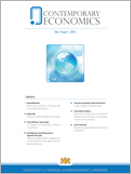Common Baltic-Nordic business cycles: Correlation- versus Markov-switching approaches
Common Baltic-Nordic business cycles: Correlation- versus Markov-switching approaches
Author(s): Scott W. HegertySubject(s): Business Economy / Management, International relations/trade
Published by: Akademia Ekonomiczno-Humanistyczna w Warszawie
Keywords: Baltic region; Nordic region; business cycles; cross-correlations; Markov-switching;
Summary/Abstract: With strong historical ties, and economic linkages that have continued to grow after the fall of the Soviet Union, the Baltic and Nordic regions form a unique economic space. How interconnected are these regions, both to each other and to the rest of the world? Greater connections can help forecast future economic linkages—and also help assess the strength of the Euro as a common currency. This study applies two methods of business-cycle analysis (cross-correlations and Markov-switching approaches) to seven countries in these regions. Both methods find evidence of a single Baltic common cycle for both output and consumption, while a Nordic cycle exists only for output, and there is no single common Baltic-Nordic cycle. Tests of correlation and concordance show there to be relatively strong connections with Germany, the U.S., and Russia—with Nordic-Baltic linkages also quite strong—but that the specific results vary by the method used.
Journal: Contemporary Economics
- Issue Year: 13/2019
- Issue No: 4
- Page Range: 427-445
- Page Count: 19
- Language: English

